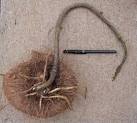Dioscorea macroura
Uses
Zanzibar (Pemba Island), Tuber is highly toxic and eating it raw or unprepared can lead to serious sickness, coma and death. To remove the poisonous compounds, it is cut into small pieces and boiled for some time then washed in cold water. This process is repeated several times after which the pieces are cooked in coconut juice [sic]. The tuber may also be processed as follows: the cut slices are buried in soil or [in the sand at?] at the sea shore and left for 3 to 4 days, after which they are dug up and washed thoroughly and left in the sun to dry. The dried slices are pounded into flour and used to make porridge. Alternately, the cut pieces are washed thoroughly and brought to a stream, pond or the sea to leach out the toxic compounds. Salt water is considered the most effective leaching agent. After soaking for a whole day. The pieces may be retrieved the following day or even same evening, washed again and eaten.
Additional Information
- Name Authority:
- Harms.
- Vernaculars:
- (Kiswahili) - Mchochoni
- Misc:
- Contains a toxicant reportedly reacting several hours after ingestion. This yam is also cultivated by the Warenga people of Central Africa.


